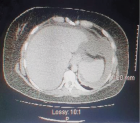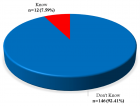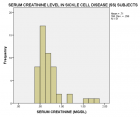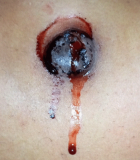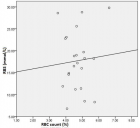Abstract
Research Article
Magnitude of aphid infestation, root rot and rust disease of lentil
Sushan Chowhan*, Majharul Islam, Mst. Rokeya Sultana, KM Eadun Nabi, Shampa Rani Ghosh, Md. Foysal Ahmmed and Hossain Md. Ferdous
Published: 31 March, 2022 | Volume 6 - Issue 1 | Pages: 015-021
Lentil is the major cultivated pulse crop of Bangladesh. Even if there are available high-yielding modern varieties of this crop but because of the higher yield gap, its demand is largely met by import. Thus, to evaluate the pest-related factors of low yield seven modern lentil varieties viz. Binamasur-5, Binamasur-8, Binamasur-9, Binamasur-10, BARI Masur-5, BARI Masur-6, and BARI Masur-8 were assessed to enquire the extent of aphid infestation, foot rot and rust disease incidence, and severity on seed yield. The experiment was laid out in a Randomized complete block design during Rabi season at BINA Sub-station, Magura. Data on insects and disease were recorded at definite SMW (standard meteorological week) and DAS (days after sowing). Outcomes divulged that maximum aphid infestation (number of aphids/plant) was noted between 7th to 9th SMW; where BARI Masur-6 had significantly lowest infestation level on 7th and 8th SMW. Summative foot rot disease incidence (%) was most in Binamasur-8 and Binamasur-9, but least in BARI Masur-6 and Binamasur-5. For rust, the highest incidence (%) was recorded with Binamasur-8 and Binamasur-5; contrary the lowest was seen with BARI Masur-6 and BARI Masur-8. Severity index (DSI) of foot and root rot was abundant by Binamasur-8 (72.89%) and Binamasur-9 (71.56%); conversely, Binamasur-10 (52.11%) and BARI Masur-8 (50%) had scarce DSI. In the case of rust, BARI Masur-5 (74.00%) showed top DSI accompanied by Binamasur-8 (58.33%). The utmost seed yield of 8.25 g/plant was produced by Binamasur-10; in contrast, the least was yielded by Binamasur-8 (5.45 g/plant). Weather factors (temperature, relative humidity, rainfall) were positively related to the number of aphids per plant. However, seed yield was negatively affected by aphid population, foot rot, and rust disease incidence. Overall, Binamasur-10 corroborated having better resilience to biotic and abiotic factors for delivering desirable economic yield
Read Full Article HTML DOI: 10.29328/journal.jpsp.1001068 Cite this Article Read Full Article PDF
Keywords:
Binamasur; BARI Masur; Foot and root rot; Rust; Aphid; Magura
References
- CGIAR Research: Areas of research; lentil (Lens culinaris M). 2003: 23.
- DAE (Department of Agricultural Extension). Pest risk analysis (PRA) of pulses in bangladesh, strengthening phytosanitary capacity in Bangladesh project plant quarantine wing, DAE, Khamarbari, Farmgate, Dhaka. 2017; 220. http://dae.portal.gov.bd/sites/default/files/files/dae.portal.gov.bd/page/902599be_5f17_4c92_9a29_676fd187c1cc/01.%202017_Final_Report_PRA_Pulse_SPCB%2C%20DAE_CRDS.pdf
- Crops and livestock products: lentil, Bangladesh. 2022. https://www.fao.org/faostat/en/#data/QCL
- BBS (Bangladesh Bureau of Statistics). Yearbook of agricultural statistics-2020. 32nd series, planning division, ministry of planning, Dhaka, Bangladesh; 2020; 92-98. https://drive.google.com/file/d/1UspiEI_SZz4qCPZUlRWE-dP3Ww68ZeL5/view?usp=sharing
- Sharma OP, Singh SK, Vennila S, Bhagat S, Saini MR, et al. Technical Bulletin no. 2014; 36.
- Collinge SK. Effects of grassland fragmentation on insect species loss, colonization, and movement patterns. Ecology. 2000. 81: 2211–2226.
- Annual Report 2068/69 (2011/12). Grain legumes research program, NARC, Rampur, Chitwan, Nepal. 2012.
- Neupane S, Subedi S, Darai R. Field screening of lentil genotypes against aphid infestation in inner Tarai of Nepal. J Nepal Agri Res Council. 2020; 6: 79–84.
- Kishor DR, Prasad R, Moses S, Singh PP. Population dynamics of aphid and pod borer on lentil and their natural enemies during rabi Season 2017 at Pusa, Samastipur. Curr J Appl Sci Technol. 2019; 32: 1-6.
- Hoque MA, Hamim I, Haque MR, Ali MA, Ashrafuzzaman M. Effect of some fungicides on foot and root rot of lentil. Univer J Plant Sci. 2014; 2: 52-56.
- Annual report 1985-86. Plant Pathology Division. Bangladesh Agri Res Institute. 1986; l9.
- Das IR, Bhuiyan MKA, Jannat R, Kayesh E, Rubayet MT, et al. Effect of bio-fortified compost in controlling soil-borne diseases of lentil (Lens culinaris) and enhance the crop growth and yield. Advan Bio Earth Sci. 2019; 4: 93-106. Available on: http://jomardpublishing.com/UploadFiles/Files/journals/ABES/V4N2/Das%20et%20al.pdf
- Chang KF, Hwang SF, Gossen BD, Turnbull GD, Wang H, et al. Effects of inoculum density, temperature, seeding depth, seeding date and fungicidal seed treatment on the impact of Rhizoctonia solani on lentil. Canadian J Plant Sci. 2008; 88: 799-809.
- Faruk MI, Islam MM, Khatun F. Formulation of eco-friendly management package against seedling disease caused by Sclerotium rolfsii of lentil. Am J Bio Sci. 2020; 8: 65-72.
- Mitiku M. Management of root rot diseases of cool season food legumes with special emphasis on lentil (Lens culinaris), faba bean (Vicia faba) and chickpea (Cicer arietinum) in Ethiopia. J Nat Sci Res. 2017; 7: 14-20. https://www.iiste.org/Journals/index.php/JNSR/article/view/36677/37691
- Ahmed D, Shahab S. Studies on interaction of Meloidogyne incognita (kofoid and white) Chitwood and Fusarium solani (Mart.) Sacc forming a disease complex in lentil (Lens culinaris). Arch Phytopathol Plant Protection. 2018; 51: 338-348.
- Vandemark GJ, Porter LD. First report of lentil root rot caused by Aphanomyces euteiches in Idaho. Plant Dis. 2010; 94: 480-480. PubMed: https://pubmed.ncbi.nlm.nih.gov/30754501/
- Musheer N, Ashraf S, Choudhary A, Kumar M, Saeed S. Role of microbiotic factors against the soil-borne phytopathogens. 2020; 251- 280.
- Aycock R. Stem rot and other diseases caused by rolfsii. Technical Bulletin No. 174. Agric Expt Station North Carolina State University, Raleigh. 1966; 202.
- BARI (Bangladesh Agricultural Research Institute). Annual Report (2020-2021), BARI, Gazipur. 2021; 365-368.
- Arti J, Tripathi HS. Studies on epidemiology of lentil rust (Uromyces viciae fabae). Indian Phytopathol. 2012; 65: 67-70. http://epubs.icar.org.in/ejournal/index.php/IPPJ/article/view/16092/7836
- Khare MN, Bayaa B, Beniwal SPS. Selection methods for disease resistance in lentil, p. 107-121. In: “Breeding for Stress Tolerance in Cool-Season Food Legumes” (Singh KB, Saxena MC, eds.). John Wiley and Sons, Chichester, U.K. 1993.
- Singh K, Jhooty JS, Cheema HS. Assessment of losses in lentil yield due to rust caused by Uromyces fabae. Lens Newsletter. 1986; 13: 28. https://agris.fao.org/agris-search/search.do?recordID=QV8700014
- Sepulveda RP. Effect of rust caused by Uromyces fabae (Pers) de bary on the yield of lentil. Agric Technol. 1985; 45: 335-339.
- Garkoti A, Kumar S, Lal M, Singh V. Major diseases of lentil: epidemiology and disease management-a review. Agriways. 2013; 1: 62-64. http://www.agriwaysjournal.com/wp-content/uploads/journals/volume1.1/MAJOR%20DISEASES%20OF%20LENTIL%20EPIDEMIOLOGY%20AND%20DISEASE%20MANAGEMENT-%20A%20REVIEW.pdf
- Annual Report 1994-1995. Bangladesh Instit Nucl Agri. 1997; 186-189.
- Bakr MA. Check list of pulse diseases in Bangladesh. Bangladesh J Plant Pathol. 1994; 10: 13-16.
- Bakr MA, Ahmed HU, Mian MAW. Proceedings of the national workshop on Strategic intervention on plant pathological research in Bangladesh. 11-12 February 2007, Bangladesh Agricultural Research Institute, Joydebpur, Gazipur. 2007; 244.
- FRG (Fertilization Recommendation Guide). Bangladesh Agri Res Council (BARC). Farmgate, Dhaka. 2012; 1215: 01-258.
- Chowhan S, Nahar K. Evaluating the Role of Fertilizer and Seed Soaking on Direct Seeded Aus Rice Varieties. Acta Sci Agri. 2022; 6: 02-17.
- Leaflet of Binamasur-8 and Binamasur-9 (In Bengali). 2014. http://bina.portal.gov.bd/sites/default/files/files/bina.portal.gov.bd/page/e598357f_0ebb_46a4_ad26_3b0bbfc4f815/Binamasur-8%20%26%209.pdf
- BINA (Bangladesh Institute of Nuclear Agriculture). Weather status, HOBOlink- Magura. 2020. https://www.hobolink.com/p/b82909d639dbdd5f400a7f2a5b54b5a0
- Ghosh SR, Chowhan S, Roy S, Roy DC, Ali MKJ, et al. Adjusting planting time of Binadhan-17 in boro Season. J Phytol. 2021; 13: 21-27.
- Ahmed F, Hasna MK, Emon RM. Ecofriendly disease management of lentil (Lens culinaris) seedlings. Agri Sci. 2021; 12: 1555-1564.
- Nene YL, Haware MP, Reddy MV. Chickpea diseases: resistance-screening techniques. ICRISAT Information Bulletin. 1981; 10: 1-10. http://oar.icrisat.org/id/eprint/1080
- Kim HS, Hartman GL, Manandhar JB, Graef GL, Steadman JR, et al. Reaction of soybean cultivars to sclerotinia stem rot in field, greenhouse and laboratory evaluations. Crop Sci. 2000; 40: 665–669.
- Data analysis software for researchers (Version 10.0). Analytical Software, 2105 Miller Landing Rd, Tallahassee Florida 32312, USA. 2021.
- Gomez KA, Gomez AA. Statistical producers for agricultural research. A Wiley Int. Sci. Pub. John Wiley and Sons, New York, Brisbane, Singapore. 1984; 139-240.
- Russell DF. MSTAT-C computer package programme. Crop and Soil Sci Dept, Michigan State University, US. 1986.
- Islam MS. Effect of sowing time and lentil varieties on incidence of insect pests and their predators. MS Thesis. Department of Entomology, Sher-e-Bangla Agricultural University Dhaka 1207, Bangladesh. 2009; 10-81. http://www.saulibrary.edu.bd/daatj/public/index.php/getDownload/SAU200901_75-08-03171_11.pdf
- El Fakhouri K, Sabraoui A, Kehel Z, El Bouhssini M. Population dynamics and yield loss assessment for pea aphid, Acyrthosiphon pisum (Harris) (Homoptera: Aphididae), on lentil in Morocco. Insects. 2021; 12: 1080.
- Farhana SNMD, Bivi MR, Khairulmazmi A, Wong SK, Sariah M. Morphological and molecular characterization of Phytophthora capsici, the causal agent of foot rot disease of black pepper in Sarawak, Malaysia. Int J Agri Biol. 2013; 15: 1083-1090. https://www.fspublishers.org/Issue.php?no_download=published_papers/70113_..pdf&issue_id=3185.
- Negussie TG, Pretorius ZA. Yield loss of lentil caused by Uromyces viciae-fabae. South African J Plant Soil. 2008; 25: 32-41.
- Roy S, Roy DC, Noor MMA, Ghosh SR, Ahmed F, et al. Binamasur-10, the first drought tolerant lentil variety registered in Bangladesh. Res Agri Livestock Fisheries. 2019; 6: 253-262.
- Salve RS, Sonkamble MM, Patil SK. Population dynamics of major insect pests of brinjal. Indian J Entomol. 2021; 83: 16–20.
- Zada H, Aur S, Ahmad S. Effect of abiotic factors on population dynamics of apple codling moth Cydia Pomonella (L) (Lepidoptera; Tortricidae) at Kalam Swat Pakistan. J Soil Sci Plant Physiol. 2020; 2: 128. https://www.researchgate.net/deref/https%3A%2F%2Fdoi.org%2F10.36266%2FJSSPP%2F128
- Kumar A, Kumar A. Effect of abiotic and biotic factors on incidence of pests and predator in cowpea [Vigna unguiculata (L.) walp.]. Legume Res. 2015; 38: 121-125.
- Agrawal AA, Underwood N, Stinchcombe JR. Intraspecific variation in the strength of density dependence in aphid populations. Eco Entomol. 2004; 29: 521-526.
- Paudel S, Bechinski EJ, Stokes BS, Pappu HR, Eigenbrode SD. Deriving economic models for pea aphid (Hemiptera: Aphididae) as a direct-pest and a virus-vector on commercial lentils. J Economic Entomol. 2018; 111: 2225-2232. PubMed: https://pubmed.ncbi.nlm.nih.gov/29982566/
- Bedasa T, Zewdie A. Evaluation of lentil varieties and seedbed types for the management of lentil Fusarium wilt disease (Fusarium oxysporum sp. lentis) in central highlands of Ethiopia. Afri J Agri Res. 2019; 14: 1012-1019.
Figures:

Figure 1

Figure 2

Figure 3
Similar Articles
-
The Importance of Potato virus Y PotyvirusMahmoud Hamdy Abd El-Aziz*. The Importance of Potato virus Y Potyvirus. . 2020 doi: 10.29328/journal.jpsp.1001044; 4: 009-015
-
Incidence and disease control of Zucchini yellow mosaic potyvirusMahmoud Hamdy Abd El-Aziz*. Incidence and disease control of Zucchini yellow mosaic potyvirus. . 2020 doi: 10.29328/journal.jpsp.1001048; 4: 033-035
-
Strobilurins: New group of fungicidesRasha E Selim*,Mohamed S Khalil. Strobilurins: New group of fungicides. . 2021 doi: 10.29328/journal.jpsp.1001062; 5: 63-064
-
Magnitude of aphid infestation, root rot and rust disease of lentilSushan Chowhan*,Majharul Islam,Mst. Rokeya Sultana,KM Eadun Nabi,Shampa Rani Ghosh,Md. Foysal Ahmmed,Hossain Md. Ferdous. Magnitude of aphid infestation, root rot and rust disease of lentil. . 2022 doi: 10.29328/journal.jpsp.1001068; 6: 015-021
-
Research progress on marker-assisted selection pyramiding breeding of disease resistance genes in wheatGuoliang Li,Yue Gao,Xiangzhao Meng,Zihui Liu,Xiulin Guo*. Research progress on marker-assisted selection pyramiding breeding of disease resistance genes in wheat. . 2022 doi: 10.29328/journal.jpsp.1001093; 6: 167-169
-
Sunflower Diseases and Downy Mildew (Plasmopara halstedii) in AdanaHale Gunacti*. Sunflower Diseases and Downy Mildew (Plasmopara halstedii) in Adana. . 2023 doi: 10.29328/journal.jpsp.1001107; 7: 066-068
-
Diversity of Rust Fungi Causing Plant Diseases in Abbottabad, Khyber Pakhtunkhwa (KP), PakistanKhursheed Ur Rahman*, Muhammad Fiaz, Ghulam Mujtaba Shah, Muhammad Ikram, Jan Alam, Mariyam Shahid, Samia Abbasi. Diversity of Rust Fungi Causing Plant Diseases in Abbottabad, Khyber Pakhtunkhwa (KP), Pakistan. . 2023 doi: 10.29328/journal.jpsp.1001118; 7: 133-138
Recently Viewed
-
Metabolic syndrome: A case reportDragan Klaric,Marta Martinis*,Marta Klaric. Metabolic syndrome: A case report. Ann Clin Endocrinol Metabol. 2021: doi: 10.29328/journal.acem.1001022; 5: 031-035
-
The Ramifications of Loneliness: A CommentaryAmi Rokach*. The Ramifications of Loneliness: A Commentary. Insights Depress Anxiety. 2023: doi: 10.29328/journal.ida.1001038; 7: 018-020
-
Antimicrobial, Antioxidant Activity of Ethyl Acetate Extract of Streptomyces sp. PERM2, its Potential Modes of Action and Bioactive CompoundsPeguy Flora Djuidje Kouomou*,Esperanza Ghomsi Guiadem,Maurice Fotsing Tagatsing,Wong Mui-Yong,Carole Beaulieu,Cecile Annie Ewane,Thaddee Boudjeko. Antimicrobial, Antioxidant Activity of Ethyl Acetate Extract of Streptomyces sp. PERM2, its Potential Modes of Action and Bioactive Compounds. Arch Case Rep. 2024: doi: 10.29328/journal.acr.1001113; 8: 134-145
-
Jaw Subluxation as a Complication of Tardive DyskinesiaDiana Paleacu Kertesz*. Jaw Subluxation as a Complication of Tardive Dyskinesia. Arch Case Rep. 2024: doi: 10.29328/journal.acr.1001112; 8: 131-133
-
Symmetry of Shank Muscle Strength, Passive Stiffness and Plantar Pressure Following IASTM Accompanied by Electrotherapy in a Case with Severe Ankle StiffnessSeyed Hamed Mousavi*,Fateme Khorramroo,Hooman Minoonejad. Symmetry of Shank Muscle Strength, Passive Stiffness and Plantar Pressure Following IASTM Accompanied by Electrotherapy in a Case with Severe Ankle Stiffness. J Sports Med Ther. 2024: doi: 10.29328/journal.jsmt.1001089; 9: 091-095
Most Viewed
-
Evaluation of Biostimulants Based on Recovered Protein Hydrolysates from Animal By-products as Plant Growth EnhancersH Pérez-Aguilar*, M Lacruz-Asaro, F Arán-Ais. Evaluation of Biostimulants Based on Recovered Protein Hydrolysates from Animal By-products as Plant Growth Enhancers. J Plant Sci Phytopathol. 2023 doi: 10.29328/journal.jpsp.1001104; 7: 042-047
-
Feasibility study of magnetic sensing for detecting single-neuron action potentialsDenis Tonini,Kai Wu,Renata Saha,Jian-Ping Wang*. Feasibility study of magnetic sensing for detecting single-neuron action potentials. Ann Biomed Sci Eng. 2022 doi: 10.29328/journal.abse.1001018; 6: 019-029
-
Sinonasal Myxoma Extending into the Orbit in a 4-Year Old: A Case PresentationJulian A Purrinos*, Ramzi Younis. Sinonasal Myxoma Extending into the Orbit in a 4-Year Old: A Case Presentation. Arch Case Rep. 2024 doi: 10.29328/journal.acr.1001099; 8: 075-077
-
Pediatric Dysgerminoma: Unveiling a Rare Ovarian TumorFaten Limaiem*, Khalil Saffar, Ahmed Halouani. Pediatric Dysgerminoma: Unveiling a Rare Ovarian Tumor. Arch Case Rep. 2024 doi: 10.29328/journal.acr.1001087; 8: 010-013
-
Physical activity can change the physiological and psychological circumstances during COVID-19 pandemic: A narrative reviewKhashayar Maroufi*. Physical activity can change the physiological and psychological circumstances during COVID-19 pandemic: A narrative review. J Sports Med Ther. 2021 doi: 10.29328/journal.jsmt.1001051; 6: 001-007

HSPI: We're glad you're here. Please click "create a new Query" if you are a new visitor to our website and need further information from us.
If you are already a member of our network and need to keep track of any developments regarding a question you have already submitted, click "take me to my Query."






